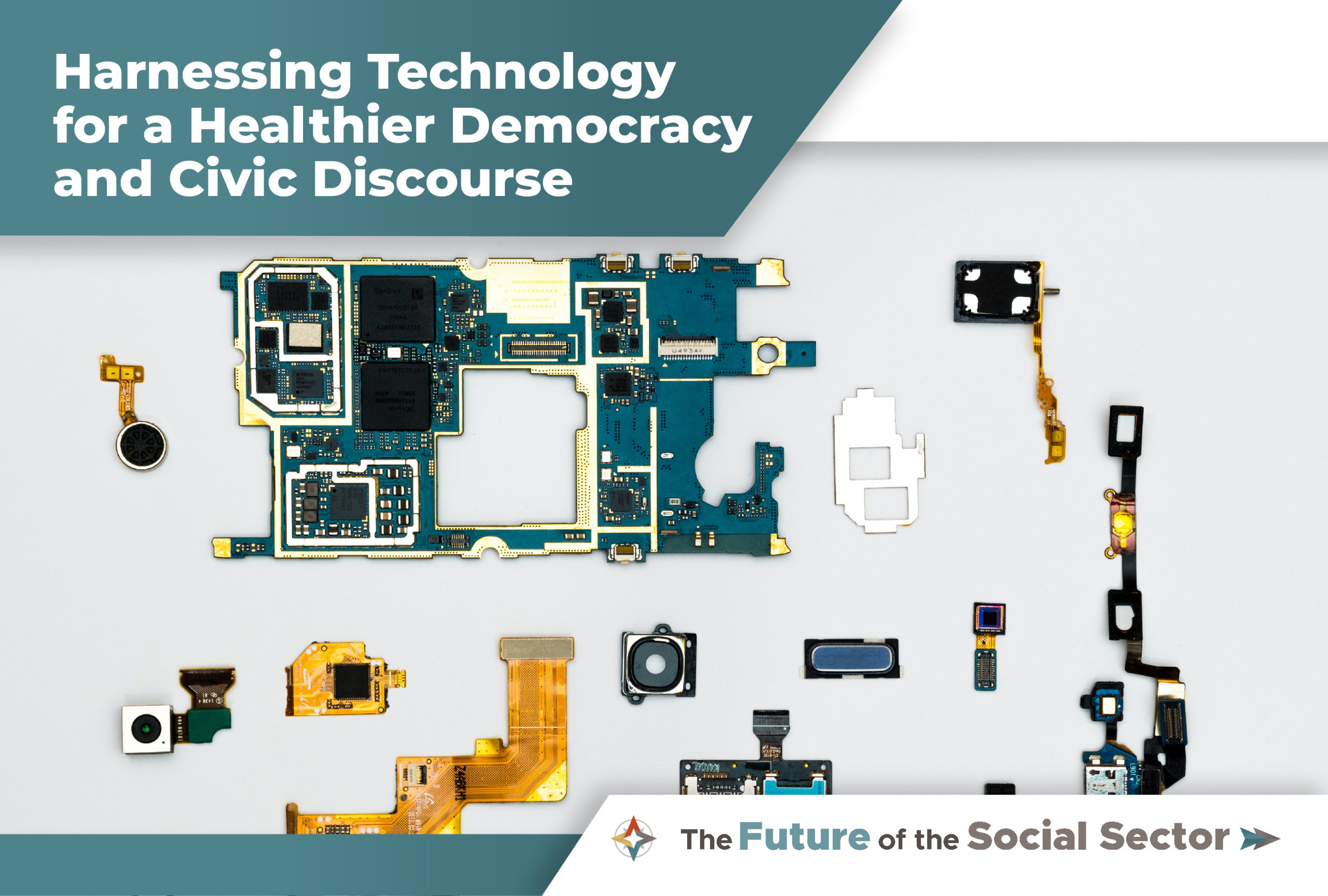Harnessing Technology for a Healthier Democracy and Civic Discourse

While it’s impossible to tie the challenges of polarization, extremism, disinformation, and social fracture to a single cause, digital media and technological platforms unquestionably play a central role. Technology’s rapid and unregulated growth has undermined our privacy and generated algorithmic biases that exacerbate existing inequities. And with midterm elections on the horizon, major tech platforms continue to enable and amplify disinformation that undermines democratic participation, intensifies our divisions, and raises the risk of political violence.
In the latest webinar in Arabella’s Future of the Social Sector series, Senior Managing Director Shelley Whelpton was joined by Eli Pariser, former executive director of MoveOn.org, Dr. Latanya Sweeney, Daniel Paul Professor of the Practice of Government and Technology at the Harvard Kennedy School, and Jenny Toomey, international program director for technology and society at the Ford Foundation, to talk about technology’s role in our fraying social fabric. They also discussed the emerging academic field of Public Interest Technology (PIT) and how the students and technologists of the future might pave the way for an approach to technology that prioritizes the public good.
The conversation revealed how deeply technology is tied to virtually every issue facing the social sector, and we invite you to watch the recording if you couldn’t attend. We’ve also gathered five important takeaways from the panel discussion below.
- The technological revolution is happening now.
To illustrate the scale of the technological changes we now face, Dr. Sweeney likened the current moment to the Second Industrial Revolution, during which new technology completely transformed every aspect of human life. While revolutionary change can come with its benefits, it also erodes the norms that once governed the way we live, and without new norms to replace them, all of our systems and social structures become vulnerable to harm. That includes our vision for a multiracial democracy: a vision, Eli reminded us, that has never been a reality for many groups in the United States to begin with. Jenny likened the destabilizing effect to playing a game of soccer with no rules: “It might be fun at first, but after a while, it’s not a game anymore.” - Tech does what power tells it to do.
Speaking about technology as an impersonal force obfuscates the power the private sector holds over how our platforms function. The disinformation, polarization, and hate that thrive in our digital spaces are not an inevitability, but rather a result of the choices we’ve made to allow private interests and profit motives to structure these environments. “If we want to create healthy digital spaces,” Eli reflected, “we have to have a positive vision for what we want, rather than allowing platforms to be vehicles for private interests.” Just as we do not leave it up to markets to build schools, libraries, and parks, the public must be proactive about shaping digital public spaces that play an essential role in our democracy and social cohesion. - The tech divide between the public and private sectors is vast.
The near-total isolation of computer science from the humanities in US universities means that individuals working in government and the civil sector are not receiving adequate tech education. This has drastic and negative real-world consequences when policymakers and regulators attempt to govern technology they don’t fully understand. Similarly, for-profit technologists are often trained to build tech from business motivations exclusively, without thinking about the broader context or consequences that technological change might have. Jenny summed up the result like this: “Separating the sciences from the humanities has never benefited society.” - Public Interest Technology envisions tech’s benefits without its harms.
The field of Public Interest Technology (PIT) seeks to bridge the gap between the public sector and the tech sector, integrating a deeper understanding of contexts and consequences into tech development and regulation. Jenny referred to PIT practitioners as having a “tech-plus” focus, and Dr. Sweeney emphasized that today’s students are eager to think about technology in this way. They see privacy, bias, ethics, and other PIT-related issues as central to technology, not separate from it. PIT is already having ripple effects on how we design and regulate technology, though the field requires more infrastructure to support students’ learning and eventual careers. - Society is hungry for change.
While tech’s harms are extremely present, our panelists ultimately struck a hopeful note. “I’m more inspired than I’ve ever been in my career,” said Eli, reflecting on the growing and vocal population of users advocating for a world where the public is technology’s customer, not its product. With PIT programs and interest groups spreading to universities nationwide and the influence of mega-platforms like Facebook and Twitter on the wane, the panel shared a sense of optimism that change is possible now—and that donors of all kinds should feel empowered to join the movement.
You can hear more insights from our panelists, including inspiring examples of PIT projects that have already changed the way we regulate and manage technology, by viewing the full recording. We hope you’ll join us for more conversations in the Future of the Social Sector series, in which we’ll discuss other ways philanthropy can break down silos and support solutions that truly work for all people.
You can register for our next Future of the Social Sector event on December 12th; in this event, Arabella principal and senior managing director, Bruce Boyd, will speak with Danielle Deane-Ryan, Director of Equitable Climate Solutions at Bezos Earth Fund, Sarah Kearney, executive director of Prime Coalition, and Michelle Martinez, Director of the Tishman Center for Social Justice and the Environment at University of Michigan. Their conversation will explore strategies that philanthropists can support that will most rapidly and effectively move our society towards a stable climate future.
